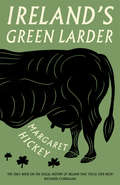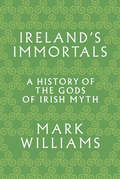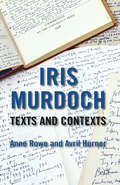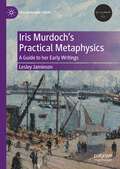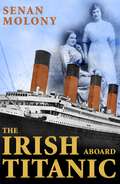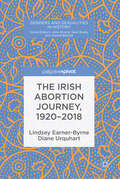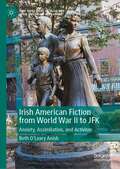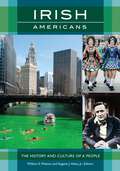- Table View
- List View
Ireland’s Green Larder: The story of food and drink in Ireland
by Margaret HickeyIreland’s Green Larder tells the story of food and drink in Ireland, for the first time. From the ancient system of the Céide Fields, established a thousand years before the Pyramids were built, right up to today’s thriving food scene.Rather than focusing on battles and rulers, Margaret Hickey digs down to what has formed the day-to-day life of the people. It’s a glorious ramble through the centuries, drawing on diaries, letters, legal texts, ballads, government records, folklore and more. The story of how Queen Maeve died after being hit by a piece of hard cheese sits alongside a contemporary interview with one of Ireland’s magnificent cheese makers, and the tale of the author’s day in Clew Bay on the wild Atlantic coast, collecting the world’s freshest oysters, is countered by Jonathan Swift’s complaint about dubiously fresh salmon being sold on the streets of Dublin.Beautifully illustrated and dotted with recipes, there are chapters covering everything from strong tea to the Irish rituals and superstitions associated with food and drink. With a light touch and a flair for finding the most telling details, Hickey draws on years of research to bring this sweeping history brilliantly to life.
Ireland's Heritages: Critical Perspectives on Memory and Identity (Heritage, Culture and Identity)
by Mark McCarthyThis book is the first sustained attempt to incorporate critical scholarship and thought at the cutting edge of contemporary geography, history and archaeology into the burgeoning field of Irish heritage studies. It seeks to illustrate the validity of multiple depictions of the Irish past, showing how scrutiny of heritage practices and meanings is so essential for illuminating our understanding of the present. Examining Ireland's heritages from a critical perspective that celebrates notions of heterogeneity and uniqueness, the distinguished contributors to this book scrutinise the multiplicity of complex relations between heritage, history, memory, commemoration, economy, and cultural identity within various historical, geographical and archaeological contexts. Using several examples and case studies, this book raises issues not only from a uniquely Irish perspective, but also investigates the memorialisation and marketing of the Irish past in overseas locations such as the USA and Australia.
Ireland's Heritages: Critical Perspectives on Memory and Identity (Heritage, Culture and Identity)
by Mark McCarthyThis book is the first sustained attempt to incorporate critical scholarship and thought at the cutting edge of contemporary geography, history and archaeology into the burgeoning field of Irish heritage studies. It seeks to illustrate the validity of multiple depictions of the Irish past, showing how scrutiny of heritage practices and meanings is so essential for illuminating our understanding of the present. Examining Ireland's heritages from a critical perspective that celebrates notions of heterogeneity and uniqueness, the distinguished contributors to this book scrutinise the multiplicity of complex relations between heritage, history, memory, commemoration, economy, and cultural identity within various historical, geographical and archaeological contexts. Using several examples and case studies, this book raises issues not only from a uniquely Irish perspective, but also investigates the memorialisation and marketing of the Irish past in overseas locations such as the USA and Australia.
Ireland's Huguenots and Their Refuge, 1662-1745: An Unlikely Haven
by Raymond HyltonThis book explores this question and attempts to reveal precisely who these Huguenots were, what they contributed to and received from their adopted land, and why Huguenot ancestry is so respected and prized even among devout Irish Catholics. The true chronicle of Irelands Huguenots is, in opposition to the narrow misrepresentations of the past, one of extraordinary richness and variety, as befits an ethnic group whose influence permeated into every nook of Irish life and society. Here are some of the towering personalities that left such an imprint on Ireland's history, character and heritage: Henri, Earl of Galway; warrior turned financial tycoon David Digues Latouche; the scholar/librarian Elie Bouhereau; and many other greater and lesser luminaries.
Ireland's Immortals: A History of the Gods of Irish Myth
by Mark WilliamsIreland's Immortals tells the story of one of the world’s great mythologies. The first account of the gods of Irish myth to take in the whole sweep of Irish literature in both the nation’s languages, the book describes how Ireland’s pagan divinities were transformed into literary characters in the medieval Christian era—and how they were recast again during the Celtic Revival of the late nineteenth and early twentieth centuries. A lively narrative of supernatural beings and their fascinating and sometimes bizarre stories, Mark Williams’s comprehensive history traces how these gods—known as the Túatha Dé Danann—have shifted shape across the centuries, from Iron Age cult to medieval saga to today’s young-adult fiction.We meet the heroic Lug; the Morrígan, crow goddess of battle; the fire goddess Brigit, who moonlights as a Christian saint; the mist-cloaked sea god Manannán mac Lir; and the ageless fairies who inspired J.R.R. Tolkien’s immortal elves. Medieval clerics speculated that the Irish divinities might be devils, angels, or enchanters. W. B. Yeats invoked them to reimagine the national condition, while his friend George Russell beheld them in visions and understood them to be local versions of Hindu deities. The book also tells how the Scots repackaged Ireland’s divine beings as the gods of the Gael on both sides of the sea—and how Irish mythology continues to influence popular culture far beyond Ireland.An unmatched chronicle of the Irish gods, Ireland’s Immortals illuminates why these mythical beings have loomed so large in the world’s imagination for so long.
Ireland's Immortals: A History of the Gods of Irish Myth
by Mark WilliamsIreland's Immortals tells the story of one of the world’s great mythologies. The first account of the gods of Irish myth to take in the whole sweep of Irish literature in both the nation’s languages, the book describes how Ireland’s pagan divinities were transformed into literary characters in the medieval Christian era—and how they were recast again during the Celtic Revival of the late nineteenth and early twentieth centuries. A lively narrative of supernatural beings and their fascinating and sometimes bizarre stories, Mark Williams’s comprehensive history traces how these gods—known as the Túatha Dé Danann—have shifted shape across the centuries, from Iron Age cult to medieval saga to today’s young-adult fiction.We meet the heroic Lug; the Morrígan, crow goddess of battle; the fire goddess Brigit, who moonlights as a Christian saint; the mist-cloaked sea god Manannán mac Lir; and the ageless fairies who inspired J.R.R. Tolkien’s immortal elves. Medieval clerics speculated that the Irish divinities might be devils, angels, or enchanters. W. B. Yeats invoked them to reimagine the national condition, while his friend George Russell beheld them in visions and understood them to be local versions of Hindu deities. The book also tells how the Scots repackaged Ireland’s divine beings as the gods of the Gael on both sides of the sea—and how Irish mythology continues to influence popular culture far beyond Ireland.An unmatched chronicle of the Irish gods, Ireland’s Immortals illuminates why these mythical beings have loomed so large in the world’s imagination for so long.
Irgendwann muss doch mal Ruhe sein!: Institutionelles Ringen um Aufarbeitung von sexualisierter Gewalt und Machtmissbrauch an einem Institut für analytische Kinder- und Jugendlichenpsychotherapie (Sexuelle Gewalt in Kindheit und Jugend: Forschung als Beitrag zur Aufarbeitung)
by Gerhard Hackenschmied Peter Caspari Helga Dill Cornelia CaspariDas Buch liefert – erstmals im deutschsprachigen Raum – einen umfassenden wissenschaftlichen Beitrag zur Aufarbeitung sexualisierter Gewalt in einem Psychotherapieinstitut. Die qualitative Fallstudie nimmt jahrzehntelangen Machtmissbrauch und sexualisierte Gewalt durch den Leiter eines analytischen Kinder- und Jugendinstituts in den Blick. Dabei zeigt sich, dass die in diesem System verstrickten Psychotherapeut*innen zentralen Vorstellungen und Konzepten ihrer Profession nicht gerecht werden: Schweigen, Verleugnung, Rationalisierung, Abwehr von Verantwortung und Ignoranz gegenüber Betroffenen verhindern über lange Zeit die Aufdeckung der Taten und nachhaltige Formen der Aufarbeitung. Das Institutsleben wird von einer dialektischen Spannung zwischen der Notwendigkeit der Bearbeitung und dem Wunsch nach ungestörtem Funktionieren geprägt. Diese Dynamik erweist sich zugleich als Analogie zu Problembewältigungsmustern psychotherapeutischer Patient*innen. Der Fall verweist auf grundsätzliche Probleme im Bereich der Psychotherapie, die vor allem mit einem strukturellen Machtungleichgewicht und ausgeprägten Abhängigkeitsverhältnissen sowohl im Kontext der Ausbildung als auch im Behandlungssetting zu tun haben. Aus den Erkenntnissen dieser empirischen Untersuchung werden professions- und organisationsethische Überlegungen abgeleitet und – darauf basierend – konkrete Empfehlungen zur Prävention von sexualisierter Gewalt in Psychotherapieinstituten formuliert.
Iris Murdoch: Texts and Contexts
by Anne Rowe and Avril HornerUsing unpublished archive material, including correspondence and the many annotations Murdoch made to the books held in her Oxford library, this book offers fresh insights into Murdoch's work by placing it within a diversity of new contexts. It also reveals startling parallels between Murdoch's work and other literary and philosophical texts.
Iris Murdoch’s Practical Metaphysics: A Guide to her Early Writings (Iris Murdoch Today)
by Lesley JamiesonThis book explores Iris Murdoch as a philosopher who, through her distinctive methodology, exploits the advantages of having a mind on the borders of literature and politics in her early career writings (pre-The Sovereignty of Good). By focusing on a single decade of Murdoch’s early career, Jamieson tracks connections between her views on the state of literature and politics in postwar Britain and her approach to the philosophy of mind and moral philosophy. Furthermore, this close study reveals that, far from a stylistic quirk, Murdoch’s use of metaphors, analogies, and other literary devices is internal to her methodology. Finally, rather than asking what Murdoch’s views are, this work will ask “what is Murdoch trying to achieve with her writings and public lectures, and how does she go about this?” By answering the latter question, we will have a new strategy for interpreting her writings more generally. The book contributes to the growing body of scholarship focusing on Iris Murdoch’s philosophical writings, and on women in the history of analytic philosophy.
Irish: The Remarkable Saga of a Nation and a City
by John BurrowesIrish is the story of the mass migration from Ireland to Glasgow that took place in the wake of the Great Famine of the mid-nineteenth century. It is an epic account of the coming together of a nation and a city. This is the tale of those who escaped a nightmare existence in the poorest and most deprived country in Europe and changed the city of Glasgow forever. Irish brings to life the horrot of those grim days and reveals the unimaginable suffering endured as a result of the Potatoe Blight. It describes in vivid detail the hazards and hardships faced by those fleeing Ireland in search of a better life overseas, including a startling account of one of the most deplorable maritime crimes ever committed, the voyage of the SS Londonderry. The coming of the Irish to Glasgow had a bigger impact on the city than other event. Now, for the first time, the truth about this most significant and stirring episode is vividly unfolded. It tells of the contribution made by Irish labourers in Glasgow to the Industrial Revolution; reveals that the legendary football clubs of Celtic and Rangers may never have existed were it not for the migrant's arrival; and describes the "Partick War", and the occasion of the first-ever Orange Walk.
The Irish Aboard Titanic: One Of Ireland's Favourite Writers
by Senan MolonyThe unspeakable tragedy of the Titanic disaster can only be fully appreciated through the tales of the people who were aboard on the night the ship went down. The Irish Aboard Titanic gives those people a voice, focusing on the Irish who were aboard the 'unsinkable' liner. In it are stories of agony, luck, self-sacrifice, dramatic escapes and heroes left behind. Senan Molony also records the heartache that continued long after that fateful night. In her wake the Titanic cast a long shadow over the families forced to endure the agonising wait to learn the fate of loved ones, over the lives of the survivors who had to start their lives anew and over those who lost relatives and friends. If you want to know about the Irish passengers and crew of the Titanic, this is the only book to have.
The Irish Abortion Journey, 1920–2018 (Genders and Sexualities in History)
by Lindsey Earner-Byrne Diane UrquhartThis book reframes the Irish abortion narrative within the history of women’s reproductive health and explores the similarities and differences that shaped the history of abortion within the two states on the island of Ireland. Since the legalisation of abortion in Britain in 1967, an estimated 200,000 women have travelled from Ireland to England for an abortion. However, this abortion trail is at least a century old and began with women migrating to Britain to flee moral intolerance in Ireland towards unmarried mothers and their offspring. This study highlights how attitudes to unmarried motherhood reflected a broader cultural acceptance that morality should trump concerns regarding maternal health. This rationale bled into social and political responses to birth control and abortion and was underpinned by an acknowledgement that in prioritising morality some women would die.
Irish American Fiction from World War II to JFK: Anxiety, Assimilation, and Activism (New Directions in Irish and Irish American Literature)
by Beth O’Leary AnishIrish American Fiction from World War II to JFK addresses the concerns of Irish America in the post-war era by studying its fiction and the authors who brought the communities of their youth to life on the page. With few exceptions, the novels studied here are lesser-known works, with little written about them to date. Mining these tremendous resources for the details of Irish American life, this book looks back to the beginning of the twentieth century, when the authors' immigrant grandparents were central to their communities. It also points forward to the twenty-first century, as the concerns these authors had for the future of Irish America have become a legacy we must grapple with in the present.
Irish Americans: The History and Culture of a People
by William E. Watson Eugene J. HalusVirtually every aspect of American culture has been influenced by Irish immigrants and their descendants. This encyclopedia tells the full story of the Irish-American experience, covering immigration, assimilation, and achievement.The Irish have had a significant impact on America across three centuries, helping to shape politics, law, labor, war, literature, journalism, entertainment, business, sports, and science. This encyclopedia explores why the Irish came to America, where they settled, and how their distinctive Irish-American identity was formed. Well-known Irish Americans are profiled, but the work also captures the essence of everyday life for Irish-Americans as they have assimilated, established communities, and interacted with other ethnic groups.The approximately 200 entries in this comprehensive, one-stop reference are organized into four themes: the context of Irish-American emigration; political and economic life; cultural and religious life; and literature, the arts, and popular culture. Each section offers a historical overview of the subject matter, and the work is enriched by a selection of primary documents.
Irish Americans: The History and Culture of a People
by William E. Watson Eugene J. Halus Jr.Virtually every aspect of American culture has been influenced by Irish immigrants and their descendants. This encyclopedia tells the full story of the Irish-American experience, covering immigration, assimilation, and achievement.The Irish have had a significant impact on America across three centuries, helping to shape politics, law, labor, war, literature, journalism, entertainment, business, sports, and science. This encyclopedia explores why the Irish came to America, where they settled, and how their distinctive Irish-American identity was formed. Well-known Irish Americans are profiled, but the work also captures the essence of everyday life for Irish-Americans as they have assimilated, established communities, and interacted with other ethnic groups.The approximately 200 entries in this comprehensive, one-stop reference are organized into four themes: the context of Irish-American emigration; political and economic life; cultural and religious life; and literature, the arts, and popular culture. Each section offers a historical overview of the subject matter, and the work is enriched by a selection of primary documents.
The Irish and the Origins of American Popular Culture (Routledge Studies in Cultural History #57)
by Christopher DowdThis book focuses on the intersection between the assimilation of the Irish into American life and the emergence of an American popular culture, which took place at the same historical moment in the late 19th and early 20th centuries. During this period, the Irish in America underwent a period of radical change. Initially existing as a marginalized, urban-dwelling, immigrant community largely comprised of survivors of the Great Famine and those escaping its aftermath, Irish Americans became an increasingly assimilated group with new social, political, economic, and cultural opportunities open to them. Within just a few generations, Irish-American life transformed so significantly that grandchildren hardly recognized the world in which their grandparents had lived. This pivotal period of transformation for Irish Americans was heavily shaped and influenced by emerging popular culture, and in turn, the Irish-American experience helped shape the foundations of American popular culture in such a way that the effects are still noticeable today. Dowd investigates the primary segments of early American popular culture—circuses, stage shows, professional sports, pulp fiction, celebrity culture, and comic strips—and uncovers the entanglements these segments had with the development of Irish-American identity.
The Irish and the Origins of American Popular Culture (Routledge Studies in Cultural History #57)
by Christopher DowdThis book focuses on the intersection between the assimilation of the Irish into American life and the emergence of an American popular culture, which took place at the same historical moment in the late 19th and early 20th centuries. During this period, the Irish in America underwent a period of radical change. Initially existing as a marginalized, urban-dwelling, immigrant community largely comprised of survivors of the Great Famine and those escaping its aftermath, Irish Americans became an increasingly assimilated group with new social, political, economic, and cultural opportunities open to them. Within just a few generations, Irish-American life transformed so significantly that grandchildren hardly recognized the world in which their grandparents had lived. This pivotal period of transformation for Irish Americans was heavily shaped and influenced by emerging popular culture, and in turn, the Irish-American experience helped shape the foundations of American popular culture in such a way that the effects are still noticeable today. Dowd investigates the primary segments of early American popular culture—circuses, stage shows, professional sports, pulp fiction, celebrity culture, and comic strips—and uncovers the entanglements these segments had with the development of Irish-American identity.
Irish Blessings Toasts & Curses
by Padraic O'FarrellIrish people have blessings, toasts, and curses for every occasion and are renowned for yarns and stories. They have a gift of the gab which may come from kissing The Blarney Stone! This collection of humourous quotations is full of wit and merriment but the sayings come from times of revolution, famine, and hardship. This volume is a treasure trove of blessings, toasts, and curses and is an ideal gift for those of Irish heritage seeking to celebrate St. Patrick's Day (or St Patty's Day!) and St Brigid's day, which is now a national bank holiday in Ireland.
Irish Blessings Toasts & Curses
by Padraic O'FarrellIrish people have blessings, toasts, and curses for every occasion and are renowned for yarns and stories. They have a gift of the gab which may come from kissing The Blarney Stone! This collection of humourous quotations is full of wit and merriment but the sayings come from times of revolution, famine, and hardship. This volume is a treasure trove of blessings, toasts, and curses and is an ideal gift for those of Irish heritage seeking to celebrate St. Patrick's Day (or St Patty's Day!) and St Brigid's day, which is now a national bank holiday in Ireland.
Irish Blood, English Heart, Ulster Fry: Return Journeys to Ireland
by Annie CaulfieldAnnie Caulfield's early years were spent by the seaside in Ireland. However, the family shifted to Sixties London and soon she wasn't sure who she was - was she English, was she Irish, and if so, what kind of Irish? Watching the news of The Troubles, she was unable to recognise the country she'd left behind. On return journeys to visit her family over the last thirty years, she discovers how much The Troubles have caused weird and successful aspects of the country's life and history to be overlooked. Caulfield's background is religiously and politically mixed, giving her a unique and often astute perspective on The Troubles. This is an Irish emigrant's tale, asking whether you can ever really go back to your roots. If you were a punk rocker when others were on hunger strike, can you really put your hand on your heart and say 'my people'? If you get a headache and go home to watch Big Brother on 12th July, are you just too flippant to understand your own country? There are many books on the recent history of Northern Ireland, but none give such a funny insight into the lives of ordinary people as Annie Caulfield's affectionate portrait of 'Alternative Ulster'.
The Irish Diaspora in Britain, 1750-1939 (Social History in Perspective)
by Donald MacRaildThis established study focuses on the most important phase of Irish migration, providing analysis of why and how the Irish settled in Britain in such numbers. Updated and expanded, the new edition now extends the coverage to 1939 and features new chapters on gender and the Irish diaspora in a global perspective.
The Irish Diaspora in Britain, 1750-1939 (Social History in Perspective)
by Donald MacRaildThis established study focuses on the most important phase of Irish migration, providing analysis of why and how the Irish settled in Britain in such numbers. Updated and expanded, the new edition now extends the coverage to 1939 and features new chapters on gender and the Irish diaspora in a global perspective.
The Irish Fairy Book: Myth And Romance From The Old World (Celtic, Irish Ser.)
by Alfred Perceval Graves George DenhamLeprechauns, fairies, and other mythical figures inhabit this entertaining collection of Irish fairy lore. The rich and representative collection of 43 tales and poems includes "The Stolen Child," a beguiling poem by William Butler Yeats; "The King of the Black Desert," by poet, scholar, and statesman Douglas Hyde; Lady Jane Wilde's "The Horned Women" and "The Demon Cat," as well as works by Joseph Campbell, Jeremiah Curtin, Alfred Lord Tennyson, Patrick Kennedy, and other distinguished writers. A valuable resource for students of Celtic lore, The Irish Fairy Book offers hours of enchanted reading for lovers of folktales.
Irish Fairy Legends (Celtic, Irish Ser.)
by T. Crofton CrokerCome sit by the fire — a world of enchantment awaits you in this treasury of classic Irish stories by folklorist T. Crofton Croker. From 1812 to 1816, he roamed southern Ireland, listening to his countrymen's stories of pixies, leprechauns, and other supernatural creatures. The result is one of the first collections of Irish fairy tales on record — and it's often considered the finest. Told in plain but colorful language with charming illustrations that capture the wonder of these tales, it became an overnight bestseller. An engaging mix of darkness and humor, the thirty-eight stories are filled to the brim with Irish wit and magic. In "The Haunted Cellar," you'll meet one of Ireland's oldest families, with blood as thick as buttermilk and a reputation for hospitality. But what is the secret in Justin Mac Carthy’s wine cellar that forces every butler to quit? In "The Changeling," a new mother finds a just solution when her infant is replaced by a mischievous fairy. "The Legend of Knockfierna" teaches fearless Carroll O'Daly a hard lesson about interfering with the "little people." And that's just a taste of the delights inside. A rich reflection of Celtic culture, Irish Fairy Legends will entertain you and your family for generations.
